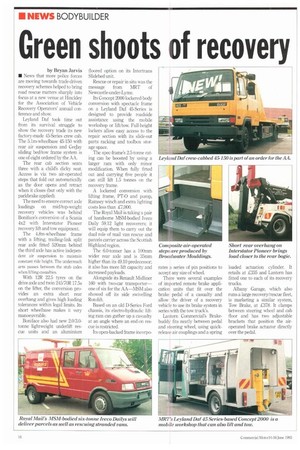Green shoots of recovery
Page 18

If you've noticed an error in this article please click here to report it so we can fix it.
by Bryan Jarvis • News that more police forces are moving towards trade-driven recovery schemes helped to bring road rescue matters sharply into focus at a new venue at Hinckley for the Association of Vehicle Recovery Operators' annual conference and show.
Leyland Daf took time out from its survival struggle to show the recovery trade its new factory-made 45-Series crew cab. The 5.1m-wheelbase 45-150 with rear air suspension and CeeJay sliding bed/tow frame system is one of eight ordered by the AA.
The rear cab section seats three with a child's dicky seat. Access is via two air-operated steps that fold out automatically as the door opens and retract when it closes (but only with the parkbrake applied).
The need to ensure correct axle loadings on mid/top-weight recovery vehicles was behind Boniface's conversion of a Scania 4x2 with Interstator Pioneer recovery lift and tow equipment.
The 4.8m-wheelbase frame with a lifting, trailing-link split rear axle fitted 520mm behind the third axle has active independent air suspension to maintain constant ride height. The underreach arm passes between the stub axles when lifting casualties.
With 12R 22.5 tyres on the drive axle and twin 245/70R 17.5s on the lifter, the conversion provides an extra short rear overhang and gives high loading tolerances within legal limits. Its short wheelbase makes it very manoeuvrable.
Boniface also had new 2.0/3.0tonne lightweight underlift rescue units and an aluminium
floored option on its Intertrans Slidebed unit.
Rescue or repair in situ was the message from MRT of Newcastle-under-Lyme.
Its Concept 2000 lockered-body conversion with spectacle frame on a Leyland Daf 45-Series is designed to provide roadside assistance using the mobile workshop or lift/tow, Full-height lockers allow easy access to the repair section with its slide-out parts racking and toolbox storage space.
The spec-frame's 2.5-tonne rating can be boosted by using a larger ram with only minor modification. When fully fitted out and carrying five people it can still lift 1.5 tonnes on the recovery frame.
A lockered conversion with lifting frame, PT-0 and pump, Ramsey winch and extra lighting costs less than £7,000.
The Royal Mail is taking a pair of handsome MS's/I-bodied Iveco Daily 59.12 light recoverers; it will equip them to carry out the dual role of mail van rescue and parcels carrier across the Scottish Highland region.
The 6.0-tonner has a 100mm wider rear axle and is 35mm higher than its 49.10 predecessor; it also has more lift capacity and increased payloads.
Alongside its Renault Midliner 160 with two-car transporter— one of six for the AA—NISM also showed off its side swivelling Rotolift.
Based on an old D-Series Ford chassis, its electro-hydraulic lifting ram can gather up a casualty at an angle where an end-on rescue is restricted.
Its open-backed frame incorpo rates a series of pin positions to accept any size of wheel.
There were several examples of imported remote brake application units that fit over the brake pedal of a casualty and allow the driver of a recovery vehicle to use its brake system in series with the tow truck's.
Lantern Commercial's Brakebuddy fits neatly between pedal and steering wheel, using quickrelease air couplings and a spring loaded actuation cylinder. It retails at £355 and Lantern has fitted one to each of its recovery trucks.
Albany Garage, which also runs a large recovery/rescue fleet, is marketing a similar system, Tow Brake, at £378. It clamps between steering wheel and cab floor and has two adjustable brackets that position the airoperated brake actuator directly over the pedal.












































































































